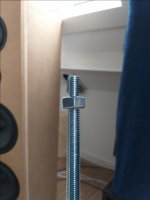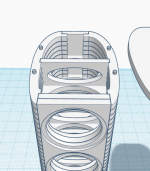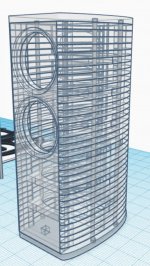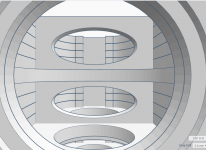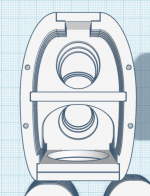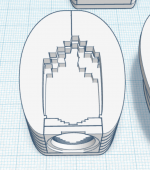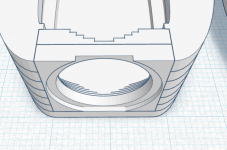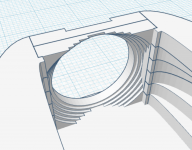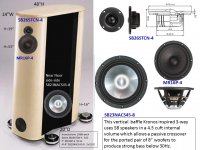when using opposite mounted woofer, they have to be mounted in the width (on the sides). Mounting one on the front and one on the back causes a time difference between the two woofers. Though, opposite side mounting the woofers (an the sides but also on front and back) I think limits the crossover frequency.
This is true. With front-back mounted woofers you have what is called the bipole dip. Whether it is an issue depends on where you XO. The shallower (and wider) the box the less the dip, but it also happens right around where you want to XO the driver if you are using the mid/bass XO as a baffle step remediation.
We have XOed as hihj as 450Hz with side mounted woofers, but those were 5.25” drivers with better higher frequency dispersion than the size woofer you are planning on.
dave
But about the butyl damping. I know it doesn't make the enclosure stiffer but I thought it is supposed to absorb vibrations in the cabinet walls. But you're saying it only lowers the resonant frequency? I f this is true, I might as well not use it but is this really true?
It does damp vibration, but only if they get excited. The side effect sare as i described. But with the woofer cabinets if you can get the potential resonances above the XO point (include the roll-off area) then it doesn’t matter a whole lot. This is easier to do without butyl damping thou.
Stiif, rigid walls with hi-Q resonances at high frequencies will never be excited.
dave
About plywood vs MDF. Do either of them have any significant acoustic advantages or disadvantages to each other? Because I don't really worry about the construction at all. I will have all the wood CNC machined by a woodworker so the dust isn't my problem and even if it was I won't worry about it at all (What's all the fuss about the dust about? Just put on a mouth cap when necessary and just clean you work space up afterwards.). For screws, well, I don't use screws. When all the wood has been cut by the CNC, I basically have on huge Lego set. To put everything together I use Bison WOODMAX, the professional version. It's even much stronger than screws, immediately seals everything up and it's super easy to work with. To make construction even simpler and perhaps offer some extra structural strength. I will be sticking two metal rods through each side panel. I can simply begin by sticking them through the middle brace and I can just stack everything up from there. Then when all the layers have been stacked up, I put bolds on both ends and bold everything together tightly. This way everything stays perfectly aligned and is pushed together very well while the kit is drying so it makes a extremely strong bond. Because they keep everything together, I can leave the baffles of, I can easily lay the wires and put in the damping material and when that's done, I can put the baffles on and... done.
Attachments
I agree, put all effort on getting the crossover right, and this can take a long time
Sure, building overkill boxes might feel good but the heart, the brain and the soul of the loudspeaker lies in the crossover
Whats a crossover ?
I save myself a whole shed load of grief and use full range drivers.
I can recommend the Fane 12-250TC or if you want a little more bass the Fane 15-300TC.
About plywood vs MDF. For screws, well, I don't use screws. When all the wood has been cut by the CNC, I basically have on huge Lego set. To put everything together I use Bison WOODMAX, the professional version. It's even much stronger than screws, immediately seals everything up and it's super easy to work with.
My speakers can be transported to different gigs so I stick to plywood which is lighter and doesn't mind a spot of rain.
Glue is definitely best as screws just have a single point of adhesion where glue works around the whole panel.
fane_diagram | Folded horn Fane cabinet | harrabylad | Flickr
folded | harrabylad | Flickr
Well my speakers will be stationary so really the heavier the better for acoustic reasons.
Exactly, and there is no pre-drilling, screwing or any of that tiring and potentially risky stuff.
Exactly, and there is no pre-drilling, screwing or any of that tiring and potentially risky stuff.
Nope, sorry, not my cup of tea.
Obviously a glutton for punishment !
I'm afraid so.
In 40 years in audio I have only ever used a crossover once.
That was 2u2 cap on a tweeter.
As my usual use for audio is for gigs so lightness is very good.
Crossover transformers are not only expensive but heavy too.
Then why not use a FusionAmp? 😀 2 X 125 watt + 1 x 100 watt tweeter output and digital crossovers, DSP, DACs and ADCs and a range of inputs in a package weighing less than a kilo. 😀
Well my speakers will be stationary so really the heavier the better for acoustic reasons
Heavy is not an advantage in a loudspeaker unless it brings other benefits. Quality 15mm plywood out does 18mm MDF. It also has other advantages.
But you are throwing many of those advantages by doing translam and not using the material in the orientation it is designed to be used in. No matter what you use it will need to be something like 2x as thick as if you used it in the manner it was intended.
And i will repeat — the horizontal braces will not have significant effect. You should have lots of vertical and only a few horizontal braces.
dave
Then what are the other advantages of plywood? Not that I would use it anyway, that would get too expensive for now.
How does using the material this way make it less stiff?
Well the horizontal and vertical braces are integrated into and reinforce each other and the horizontal braces also reinforce the baffle and rear so de do certainly serve a purpose. But the way I will be constructing the sides makes the bond between the layers extremely strong and and act like a single piece, I'm sure. The Woodmax kit and metal rods (which are 12M thick stainless steel by the way, extremely strong) keeping everything packed together extremely tightly will definitely transform the layers back into a single panel. So the horizontal braces should definitely also reinforce the sides. And the sides are 3,5 cm thick which is extremely thick and there also are all these vertical braces which are an additional 2,5 cm. It should be extremely rigged.
How does using the material this way make it less stiff?
Well the horizontal and vertical braces are integrated into and reinforce each other and the horizontal braces also reinforce the baffle and rear so de do certainly serve a purpose. But the way I will be constructing the sides makes the bond between the layers extremely strong and and act like a single piece, I'm sure. The Woodmax kit and metal rods (which are 12M thick stainless steel by the way, extremely strong) keeping everything packed together extremely tightly will definitely transform the layers back into a single panel. So the horizontal braces should definitely also reinforce the sides. And the sides are 3,5 cm thick which is extremely thick and there also are all these vertical braces which are an additional 2,5 cm. It should be extremely rigged.
plywood? Not that I would use it anyway, that would get too expensive for now.
The expense is worth it… especially whem you consider all the other costs involved.But then the way you are building these you are not using the material the way it was intended and your waste is going to be a very large amount of your wood allowance. I expect a more elegant approach to construction could well end up using considerably less material.
dave
Forgot — with MDF the dust can get into your eyes so you really need a full-face mask if you are anywhere near it.
dave
dave
But about the butyl damping. I know it doesn't make the enclosure stiffer but I thought it is supposed to absorb vibrations in the cabinet walls. But you're saying it only lowers the resonant frequency? I f this is true, I might as well not use it but is this really true?
The resonance is determined by the dimensions, the thickness, the compilance (how much it bends under a certain force) and the material inner damping.
The resonance frequency goes down
if the compilance is decreased (bends easier).
if the size is increased.
if the weight is increased.
If you add butyl, you are increasing the mass but not the compilance or size. So: Yes, it lowers the resonance frequencies of the parts.
With the internal stiffening matrix you are increasing the resonances to higher frequencies since the smaller surfaces between the parts, so it's the opposite concept. It's probably not the best idea to mix both concepts, you will not get much (any?) gain of it.
Butyl is great to treat some pressed steel baskets (like the old 8-12" Philips fullrange) or aluminium cast horns and on some flimsy (plastic) horns because you dampen the resonances greatly, lower the Q of the resonances (not increase it) and lower the resonances. As everything, it's only as good as how good you are using it.
Yeah, well then it's clear to me the butyl is unnecessary. To be avoided in fact.
I increased the thickness of all braces. I figured it doesn't cost anything but will again greatly increase stiffness. I'm sure these cabinets will now be extremely stiff. Where the holes in the vertical braces are at their widest (in the middle) the walls are already 7,25 cm thick. The resonant frequency will be far above the pass band.
About the way I construct these cabinets. No, stacking is not at all a material efficient way of building them, but I don't know how to get this shape otherwise without getting extremely complicated with shaping my own plywood in a press and such. That's just way too complicated.
I increased the thickness of all braces. I figured it doesn't cost anything but will again greatly increase stiffness. I'm sure these cabinets will now be extremely stiff. Where the holes in the vertical braces are at their widest (in the middle) the walls are already 7,25 cm thick. The resonant frequency will be far above the pass band.
About the way I construct these cabinets. No, stacking is not at all a material efficient way of building them, but I don't know how to get this shape otherwise without getting extremely complicated with shaping my own plywood in a press and such. That's just way too complicated.
Attachments
Last edited:
For the midrange chamber, the sides and top and bottom already were very stiff because of the big pieces of wood that make up the diffuser though the baffle was only a single layer. I now also made the midrange baffle double layered but beveled. This does take back away a lot of the thickness but it's still something thicker, and at the same time acoustics are actually improved.
Attachments
The woofers generate most of the cabinet vibration, which can be avoided if you mount them side-side for counter-force cancellation. Mounting both woofers close the floor will provide uniform floor gain, which simplifies the crossover and equalization. A good 6" midrange will have a low enough crossover to maintain a quarter-wavelength point-source imaging to 8" woofers about 12" above the floor. High quality(low-Le, reduced cone breakup), 6" midranges have become popular because they cover the entire vocal range without a crossover. The SB MR16P-4 is one example. You can construct a "V-shaped" volume behind the midrange to reduce resonances like a tapered tube. Just create a large volume directly behind the midrange for large air pressure changes, and put absorption material in the tapered rear volume.
You can focus on either "soft mounting" (rubber O-rings) the midrange and tweeter to the front baffle, or adding a couple pounds of sand compartments into the front baffle. With side woofers, the front baffle can now have very low edge diffraction 3" radius round overs and still maintain a narrow appearance. The heavy 3" thick front baffle can also be constrained layer attached to the cabinet for further isolation.
The front baffle 3" radius rounds can be saw-cut and belt sanded, or machined on a cabinet shop shaper. Plywood panels construct main cabinet. No CNC required.
You can focus on either "soft mounting" (rubber O-rings) the midrange and tweeter to the front baffle, or adding a couple pounds of sand compartments into the front baffle. With side woofers, the front baffle can now have very low edge diffraction 3" radius round overs and still maintain a narrow appearance. The heavy 3" thick front baffle can also be constrained layer attached to the cabinet for further isolation.
The front baffle 3" radius rounds can be saw-cut and belt sanded, or machined on a cabinet shop shaper. Plywood panels construct main cabinet. No CNC required.
Attachments
- Status
- Not open for further replies.
- Home
- Loudspeakers
- Multi-Way
- Redesigning my cabinets. Thoughts?

